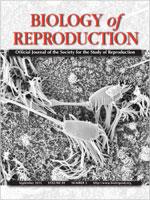In preparation for embryo implantation and pregnancy, the uterine epithelium undergoes a genomic and biological transition that mediates adhesion and invasion of the blastocyst. These events resemble an inflammatory response, and the immune system likely takes an active role in the establishment and maintenance of pregnancy. Although glucocorticoids are primary mediators of the immune system, the functional role of glucocorticoid signaling in the uterine epithelium is not well defined. To investigate the dynamic relationship between glucocorticoids and reproductive hormones, we performed whole-genome microarray analysis in a human uterine endometrial cancer cell line (ECC1 cells) treated with the synthetic glucocorticoid dexamethasone (Dex) alone or in combination with estradiol (E2). Over 10 000 genes were significantly regulated in the presence of Dex and/or E2. Surprisingly, unique targets of Dex and E2 together represented the largest group of regulated genes. Ingenuity pathway analysis found both overlapping and independent regulated networks for each hormone. Several hundred genes were found to be coregulated by Dex and E2, including several that were antagonistically regulated. The effects of glucocorticoids and E2 are mediated primarily through the glucocorticoid receptor (NR3C1) and estrogen receptor (ESR1), respectively. In silico promoter analysis revealed that NR3C1 and ESR1 response elements are enriched in antagonistically regulated genes, and signaling through these receptors was required for antagonism. Glucocorticoid and E2 antagonism of target genes may represent a critical junction between the immune system and female reproductive system. Moreover, identification and ontology analysis of glucocorticoid-regulated genes in a uterine epithelial-like cell line suggests that glucocorticoid signaling regulates important biological functions, including immune cell trafficking and embryonic development.
How to translate text using browser tools
10 July 2013
Global Gene Expression Analysis in Human Uterine Epithelial Cells Defines New Targets of Glucocorticoid and Estradiol Antagonism
Shannon Whirledge,
Xiaojiang Xu,
John A. Cidlowski
ACCESS THE FULL ARTICLE

Biology of Reproduction
Vol. 89 • No. 3
September 2013
Vol. 89 • No. 3
September 2013
epithelial cells
ESR1
estrogen receptor
glucocorticoid receptor
microarray
NR3C1
uterus




